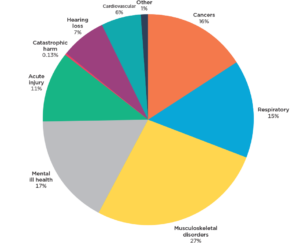-
On average 75 people die on the job.
-
1 in every 10 people each year are harmed in workplaces,
-
750-900 die from work related ill-health diseases each year.
-
There are an estimated 5,000-6,000 hospitalisations each year due to work-related ill-health.
-
A worker is 15 times more likely to die from a work-related disease than from a workplace accident.
By law, businesses must manage both the health and safety risks caused by their work. That includes managing mental as well as physical health risks.
For WorkSafe, work-related health is about the way work can impact on worker health and the way worker health may impact on working safely.
WorkSafe needs to understand the impact of work-related disease so it can develop effective ways to improve worker health. It does this using work-related health estimates and burden of harm estimates informed by comprehensive international research.
These estimates are used to compare between illness caused by long-term exposure to hazards, and illness caused by acute injury.
Work Related Ill-Health
Work-related health is about the impact work can have on people’s health. In the past, we’ve called it occupational health.
New Zealand’s organisations can’t keep prospering if their people aren’t healthy. Everyone who goes to work should come home healthy and safe.
There are a range of risks at work that can affect a worker’s health. They include: psychosocial (including bullying and harassment), biological, physical, ergonomic, and chemical risks.
For WorkSafe work-related health is about the way work can impact on worker health and the way worker health may impact on working safely.
By law organisations must manage both the health and safety risks caused by their work. That includes managing mental as well as physical health risks. Work-related ill-health is largely preventable with attention from organisations.
Work-related ill-health estimates
Up to 900 people die in New Zealand each year from work-related causes and there are an estimated 5000-6000 hospitalisations because of the health risks associated with work.
There are several thousand ACC claims for gradual process injuries, such as noise-induced hearing loss.
Many more cases of work-related illness are unreported or are not linked back to a person’s work.
The burden on workers, their families and the wider economy from work-related ill-health far outweighs the burden from work-related injuries.
We are committed to reducing work related ill-health and diseases as well as ensuring those who create the risk are responsible for improving management of work-related health risks. Organisations need to understand and work to mitigate or reduce risk in this area.

Burden of harm estimates from work-related injury and work related ill-health
We have also applied a statistical measure of the quality and length of life lost to injuries and illness, using work-related health estimates and burden of harm estimates.
This measure is called disability-adjusted life years (DALYs) lost and puts a value to the burden of harm from work-related ill-health and injury.
Different diseases will have different harm profiles. The measure enables comparison between diseases with different harm profiles.
It is used to determine which diseases account for the most ill-health. It also enables comparison between work-related acute injuries and work-related ill-health.
Work-related health estimates
WorkSafe recently revised its work-related health estimates to take into account new international research, and other information to inform decisions to improve worker health.
-
Work-related health deaths are estimated at 750-900 a year.
-
There are an estimated 5,000-6,000 hospitalisations each year due to work-related ill-health.
-
A worker is 15 times more likely to die from a work-related disease than from a workplace accident.
Burden of harm estimates from work-related injury and ill-health
WorkSafe has also applied a statistical measure of the quality and length of life lost to injuries and illness, using work-related health estimates and burden of harm estimates.
This measure is called disability-adjusted life years (DALYs) lost and puts a value to the burden of harm from work-related ill-health and injury.
Different diseases will have different harm profiles. The measure enables comparison between diseases with different harm profiles.